Pain on Back of Knee and Upper Calf
Medically reviewed by Dr. Chaminda Goonetilleke, 30th Nov. 2021
Pain at the back of the knee is known as posterior knee pain. Here we explain the common injuries which cause both sudden onset (acute) and gradual onset (chronic) knee pain.
Click headings to expand:
Acute pain behind the knee
Acute pain behind the knee usually occurs suddenly and includes ligament sprains, muscle/tendon strains and bone fractures. As a result, you will often be able to pointpoint a specific time that your injury occured.
The following are common acute injuries which cause pain at the back of the knee:
Hamstring tendon strain
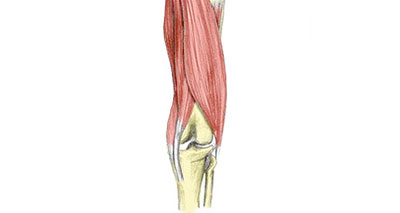
A hamstring tendon strain is a tear of one of the hamstring tendons. Most commonly torn is the tendon of the biceps femoris muscle, specifically at the point of insertion at the back of your knee.
This injury is more common in sprinters or sports involving kicking. Symptoms include:
- A sudden sharp pain in the back of your knee.
- You may have swelling, tenderness and/or heat at the site of injury.
- It is important to get an accurate diagnosis and rule out a complete tendon rupture, or an avulsion strain (see below).
- More on biceps femoris tendon rupture
Biceps femoris tendon avulsion
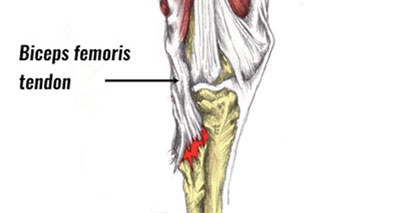
An avulsion strain occurs when a tendon tears, pulling a small piece of bone with it. If you suspect you have an avulsion injury, seek professional advice. This is because an X-ray is needed to confirm the diagnosis. Symptoms of an avulsion strain:
- A sudden severe pain at the back of your knee (similar to that of a hamstring tendon strain).
- Sudden swelling will occur.
- Your knee will be particularly tender at a point on the back of your knee.
- More on biceps femoris tendon avulsion
Posterolateral corner injury
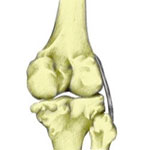
The Posterolateral corner of the knee consists of a number of structures. It is a less common cause of pain at the back of the knee. Symptoms can include any of the following:
- Pain and swelling at the back, and outside of your knee.
- Tenderness on the outside of your knee when pressing in.
- Knee joint instability.
- More on Posterolateral corner injury
Chronic pain behind the knee
Pain at the back of the knee may occur gradually. You are unlikely to be able to pinpoint the exact time your injury occurred. These injuries often start out as a 'niggle' which you may attempt to ignore. Eventually, they become progressively worse.
An acute injury may become chronic if it is not treated properly, or fails to heal.
Chronic knee injuries can be more difficult to treat so do not ignore the early signs!
Baker's Cyst
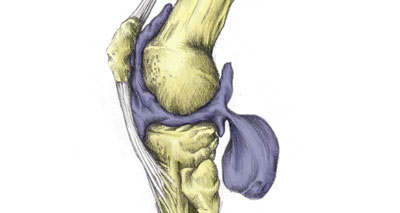
A Baker's Cyst or Popliteal cyst is a swelling that protrudes out the back of the knee. It is often about the size of a golf ball but can vary over time. Symptoms consist of:
- You will feel sensation of pressure in the back of your knee.
- You will have difficulty bending the knee.
- More on Baker's Cyst
Gastrocnemius tendinopathy
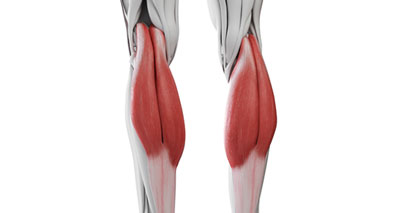
Gastrocnemius tendinopathy (or tendinitis) is inflammation (or more likely degeneration) of the calf muscle tendon at the back of the knee. This is an overuse injury which is more common in runners and sprinters. Symptoms include:
- Gradual onset pain behind the knee, often localized to a specific point.
- Your knee will feel tender when pressing it at the back of your knee.
- Going up on tip toes with your legs straight may be painful.
- More on Gastrocnemius tendinopathy
Biceps femoris tendinopathy
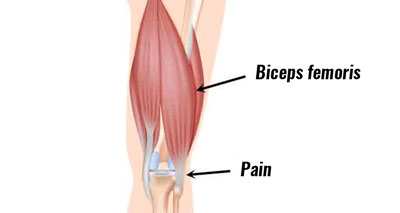
Biceps femoris tendinopathy or biceps femoris tendonitis is inflammation (or more likely degeneration) of the hamstring tendon where it inserts at the back of your knee. Symptoms include:
- Tenderness and swelling at a specific point at the back of your knee.
- Pain is likely to have developed over time.
- You may have stiffness in the morning, or after sitting for long periods.
- More on Biceps femoris tendinopathy
Popliteus strain/tendinopathy
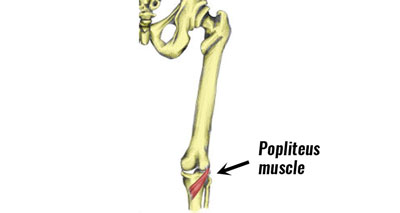
The Popliteus is a small muscle located at the back of the knee. The muscle, or tendon can be torn, especially from twisting activities, or injuried through overuse. Symptoms may include:
- Acute (sudden onset), or gradual onset pain behind the knee.
- The back of your knee will feel tender when pressing in.
- Trying to bend your knee against resistance, whilst your tibia (shin) bone is turned outwards is a specific test used to help diagnose a Popliteus injury.
- More on Popliteus strain/tendinopathy
Referred knee pain
Posterior knee pain can be caused by injuries or dysfunction in the lower back and hips. Symptoms may include:
- Sciatic pain which radiates down into the back of your leg, knee and/or lower leg.
- The slump test is to identity sciatic type referred pain.
Knee joint swelling
Swelling within the knee joint is a symptom rather than a specific injury. Swelling alone can be enough to cause pain and tightness behind the knee. A full knee assessment should be done to identify the root cause of any effusion (swelling). Previous injuries can often be the cause of chronic knee swelling and development of a Baker's Cyst.
Knee rehabilitation & exercises
Recommended products
We recommend the following products to help treat knee ligament injuries
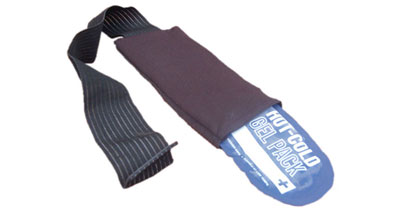
Cold compresion wrap
A cold therapy and compression wrap is essential first aid. It reduces pain and swelling and can also be used to apply heat later in the rehabilitation program.

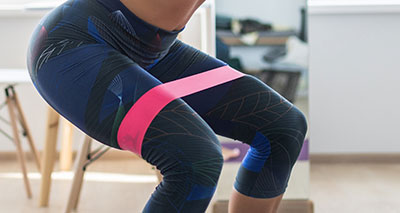
Resistance bands
Resistance bands are important for most sports rehabilitation and enable you to exercise any muscle from the comfort of your own home.

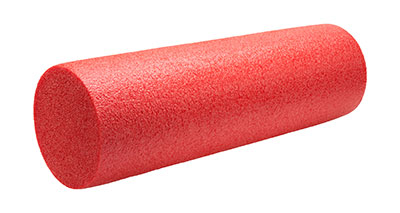
Foam roller
A foam roller is an excellent piece of kit which can be used in place of massage to treat calf injuries. They are also excellent when use regularly as part of your warm up to help prevent future injury and improve performance.

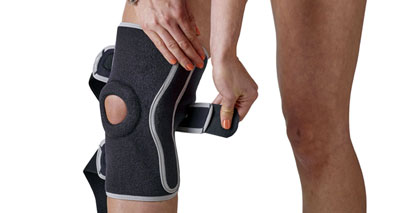
Hinged knee brace
A hinged knee brace protects the joint and helps reduce any swelling. It has solid metal supports down the sides to prevent sideways movement of the joint. Grade 2 or 3 injuries may require a limited motion hinged knee brace.

Pain on Back of Knee and Upper Calf
Source: https://www.sportsinjuryclinic.net/sport-injuries/knee-pain/posterior-knee-pain